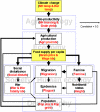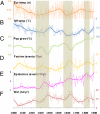The causality analysis of climate change and large-scale human crisis
- PMID: 21969578
- PMCID: PMC3198350
- DOI: 10.1073/pnas.1104268108
The causality analysis of climate change and large-scale human crisis
Abstract
Recent studies have shown strong temporal correlations between past climate changes and societal crises. However, the specific causal mechanisms underlying this relation have not been addressed. We explored quantitative responses of 14 fine-grained agro-ecological, socioeconomic, and demographic variables to climate fluctuations from A.D. 1500-1800 in Europe. Results show that cooling from A.D. 1560-1660 caused successive agro-ecological, socioeconomic, and demographic catastrophes, leading to the General Crisis of the Seventeenth Century. We identified a set of causal linkages between climate change and human crisis. Using temperature data and climate-driven economic variables, we simulated the alternation of defined "golden" and "dark" ages in Europe and the Northern Hemisphere during the past millennium. Our findings indicate that climate change was the ultimate cause, and climate-driven economic downturn was the direct cause, of large-scale human crises in preindustrial Europe and the Northern Hemisphere.
Conflict of interest statement
The authors declare no conflict of interest.
Figures




References
-
- Atwell WS. Volcanism and short-term climatic change in East Asian and world history, c. 1200-1699. J World Hist. 2001;12:29–98.
-
- Atwell WS. Time, money, and the weather: Ming China and the 'great depression' of the mid-fifteenth century. J Asian Stud. 2002;61:83–113.
-
- deMenocal PB. Cultural responses to climate change during the late Holocene. Science. 2001;292:667–673. - PubMed
-
- Weiss H, Bradley RS. Archaeology. What drives societal collapse? Science. 2001;291:609–610. - PubMed
-
- Bryson RA, Murray TJ. Climates of Hunger: Mankind and the World's Changing Weather. Madison, WI: Univ of Wisconsin Press; 1977.
Publication types
MeSH terms
LinkOut - more resources
Full Text Sources
Medical
Miscellaneous

